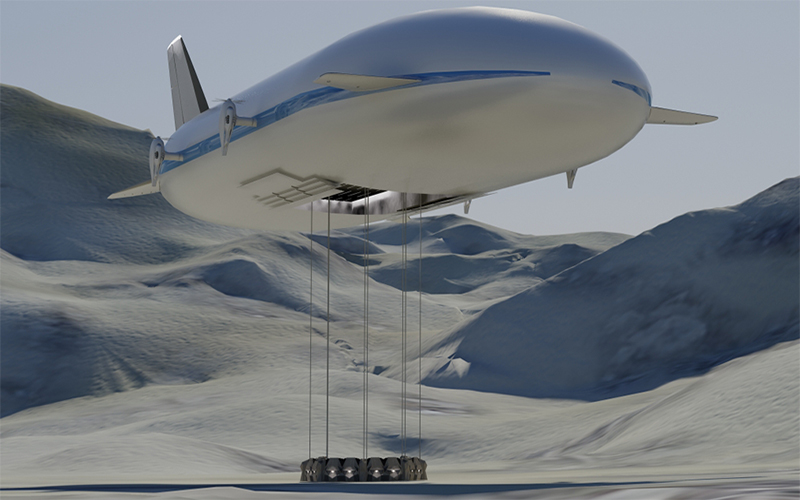Air Cargo Ships Could Soon Alter Global Supply Chains As We Know Them

Igor Pasternak, the CEO and chief engineer of Worldwide Aeros, is fulfilling his lifelong dream of creating aircrafts that are lighter than air, more fuel-efficient and "greener" and his Aeroscraft is gaining recognition and significant funding.
Igor Pasternak, CEO and chief engineer, founded Worldwide Aeros Corp. (Aeros) 25 years ago fueled by a dream to resurrect an aircraft category that once had huge potential.
Pasternak [who was recently profiled in The New Yorker - view video above] turned that dream into what Aeros has become today, one of America’s most innovative FAA-certified lighter-than-air (LTA) manufacturing companies.
In this exclusive interview for Supply Chain Management Review, Pasternak shares fresh insights on the state of the industry.
How will airships compete with jumbo cargo carriers currently in the marketplace?
They’ll compete in many ways. Importantly, Aeroscraft will access more austere areas directly, independent of infrastructure (VTOL), more easily move large ‘project’ cargo, and accommodate shipping containers and cargo on pallets.
The Aeroscraft’s cargo bay will measure (LWH) 220’ x 40’ x 30’ on the smaller 66-ton payload aircraft (ML866), much larger on our 250 ton aircraft, and will overcome the dimensional accommodation challenges arising from nose/tail loading of the fixed-wing fuselage. Aeroscrafts will also consume less than 1/3 that of freighters on a per ton-mile basis by using helium to stay aloft (static lift), and propulsion simply to move forward and overcome aerodynamic drag.

Igor Pasternak, founder and CEO of Worldwide Aeros Corp. (left) with Corky Belanger, Worldwide Aeros Corp.’s veteran lighter-than-air (LTA) and test pilot.
We anticipate these vehicles will empower traditional energy, alternative energy, project engineering, mining, agriculture, manufacturing and other global industries by reducing their unique logistics challenges for specialty cargo.
The Aeroscraft will help with product movement while retaining warranty in some cases, reduce on-site final assembly (time/cost) in others, overcome seasonal limitations like ice road deliveries, or deliver other project management benefits like shorter development schedules and reduction of idled equipment and manpower.
The Aeroscraft will also provide new opportunities and efficiencies for the transport of certain sub-segments of global commercial cargo and traditional air cargos. The Aeroscraft’s landing site flexibility, global reach, payload capability and faster speed than existing ground modes, are further expected to provide expanded opportunities for military airlift and humanitarian/ disaster relief efficiency.
Will air ships collaborate with commercial air cargo carriers?
I believe they will. The Aeroscraft will introduce a speed and cost intermediary between sealift and airlift. For air cargo operators, our vertical take-off and landing Aeroscraft will likely broaden network reach.
Thinking of just a few examples, it could also expand service capabilities for perishable cargos (field access, power for refrigerated containers), move hazardous belly cargo quickly (LI batteries, etc.), enhance security for sensitive cargo relative to current intermodal practices, or facilitate introduction of new multi-day global delivery services appropriate for certain cargo/packages.
Certain cargo types may shift toward the Aeroscraft for reduced delivery cost while providing global reach at speed surpassing surface modes, or for point-to-point/ volume efficiencies providing speed and cost benefits distributing retail (CPG, CE, apparel) products. Aeroscraft would facilitate direct delivery to new places including regional distribution centers, offering a new alternative to air/truck intermodal.
Will airships also work with ocean cargo carriers in an air/sea strategy?
Again, yes, I believe they will. Aeroscraft will be able to access and operate in both harbor environments and remote areas without support equipment.
I expect cargo airships may serve ocean cargo carriers by moving containers from more remote areas with insufficient road/rail infrastructure to main container terminals, and facilitate similar reverse distribution. Their capabilities to augment existing main line vessel support will likely help operators expand services, particularly in the arctic and Asia-Pacific regions.
Aeroscrafts would also serve ocean-based logistics providers by speeding delivery to countries lacking an ocean harbor (land locked countries), where intermodal transport combined with customs can slow final destination delivery, especially for higher-value, lower-density (HVLD) containers.
The aircraft’s container capacity will vary depending on loading. (Whereas most aircraft today are volume constrained before they are weight constrained, we’ll typically be weight constrained before becoming volume constrained.) (see chart)
With the capability to precisely deploy cargo from hover (landing not required), or on-board cargo while hovering, Aeroscraft can also expedite cargo movement to and from off-shore container vessels, when required.
Which emerging nations are likely to see the first use of cargo air ships?
Cargo airships will be particularly attractive for emerging nations that have less developed infrastructure.
I am unable to identify specific countries at this time, but can say earliest adopters will be those where the Aeroscraft reduces the need for major infrastructure investments to facilitate economic development projects/initiatives to the greatest extent. (e.g. where use would negate the need to build a special airport for project cargo, mitigate port/terminal construction and its associated inland infrastructure for regional development, or minimize environmental impacts in prized pristine places).
Are there any security advantages that airships provide?
Yes, because cargo can be delivered directly from ‘point of origin’ to ‘point of need’ by our VTOL-enabled aircraft in a secure internal bay, cargo security will be enhanced compared to intermodal means involving more handling, transfers and/or storage.
Why has it taken the industry so long to recognize the value of air ships?
While difficult to speak for the industry, I do have some ideas and insight. The logistics industry is filled with intelligent, logical and mission oriented professionals much more familiar with other transport modes and technology.
Infrastructure has been a component of transport since Roman times, often still dictating the width of roads, so the opportunities arising from infrastructure-independent transport are generally not top of mind. False starts and broken promises by other earlier cargo airship concepts have certainly contributed to skepticism about such innovation.
Perhaps it has taken the U.S. military’s recent interest, exploration and incubation of LTA technologies for the larger commercial industry to realize that the utility and benefits modern cargo airships would provide soldiers were so highly transferable to commercial markets.
To explain, Aeros’ military partners DARPA/DOD were seeking benefits to operational tempo and mission flexibility, enhanced delivery capability, and operational cost savings in enduring logistical sustainment operations.
Cargo airships deliver something between high-speed, lower-capacity airlift, and low-speed, higher-capacity sealift, supporting a range of strategic and tactical missions. For the military, this new generation of airships has the potential to:
- greatly increase heavy cargo lift capability
- better facilitate direct delivery to austere locations
- reduce the logistics footprint in theater
- reduce dependence on airbases and ports
- minimize surface convoys and susceptibility
- reduce the effectiveness of anti-access strategies employed by adversaries
- and augment the hub and spoke logistics structure to one of point-to-point delivery
An aircraft purposely designed to address military logistics challenges delivers similar opportunity for value creation within the wider logistics community.
In addition, cargo airships have enormous potential to enable economic development opportunities and accelerate export logistics, expand capabilities in disaster relief response, and drive greenhouse gas reductions in global aviation.
I believe these may be some of the secondary opportunities, more recently realized and championed, that are now elevating the holistic value recognition for airships within the logistics profession.
Related: Air Freight Forwarders Greet New Project Cargo Scheme with Enthusiasm

Article Topics
Aeros News & Resources
Air Cargo Ships Could Soon Alter Global Supply Chains As We Know Them A Whole New Way to Transport Cargo Air Freight Forwarders Greet New Project Cargo Scheme with Enthusiasm ‘Airshipping’- Perhaps the Logistics of Freight by Blimp aren’t Just Hot AirLatest in Transportation
Baltimore Bridge Collapse: Impact on Freight Navigating Amazon Logistics’ Growth Shakes Up Shipping Industry in 2023 Nissan Channels Tesla With Its Latest Manufacturing Process Why are Diesel Prices Climbing Back Over $4 a Gallon? Luxury Car Brands in Limbo After Chinese Company Violates Labor Laws The Three Biggest Challenges Facing Shippers and Carriers in 2024 Supply Chain Stability Index: “Tremendous Improvement” in 2023 More TransportationAbout the Author














